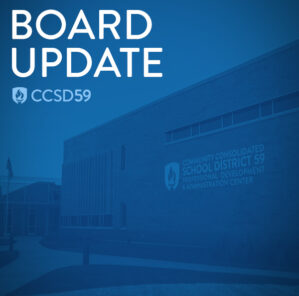Accelerated Placement
Accelerated Placement
“Accelerated placement” is the placement of a student at the instructional level that best matches the student’s needs by allowing access to a curriculum that is usually reserved for children who are older or in higher grades than the student. Accelerated placement options must include, but need not be limited to, early entrance to kindergarten and first grade, individual subject acceleration, and whole grade acceleration. Accelerated placement is not limited to those students who have been identified as gifted and talented, but rather is open to all students who demonstrate high ability and who may benefit from accelerated placement.
Eligibility for accelerated placement shall also be open to all students regardless of race, ethnicity, gender, religion, sexual orientation, disability, English language proficiency, or socioeconomic status.
EARLY ENTRANCE
CCSD59 complies with Illinois law which specifies that to enter kindergarten or first grade, children must be five years of age by September 1st of their kindergarten year or six years of age by September 1st of their first-grade year (105 ILCS 5/10-20.12). However, parents who feel that their child’s potential and skills are in the superior range when compared with their peers can apply for early entrance.
Early entrance to kindergarten or first grade is considered a form of whole grade acceleration and is appropriate only for those students who demonstrate compelling evidence that they are both intellectually and socially advanced. The decision to grant early entrance will be made after careful examination of relevant evidence that is provided by the parents or gathered through a district evaluation process.
Please consider: The decision for a child to enter school early can have a profound effect on his or her academic and social performance for the remainder of the child’s school career. It is a decision that needs to be taken very seriously and should not be considered for daycare reasons. Academic readiness, academic potential, and social-emotional maturity are all equally important considerations. Children who enter kindergarten or first grade early may demonstrate social or emotional difficulties due to their relative immaturity. As they progress through school, children who are young for their grade level may have more difficulty fitting in with their peers in social situations. They are less likely to excel in sports because of their age and/or their smaller size. These and other possible effects of being younger than others in their classes should be considered carefully. In addition, please be aware that very few children who are evaluated meet the criteria to enter kindergarten or first grade early.
After reviewing the information at the links below, you can contact the Instruction Department if you have questions about the Early Entrance process at 847-593-4305.
a
Early Entrance to KindergartenEarly Entrance to First Grade
Evaluation Process and Probation PeriodWhole Grade and Single Subject Accelerations
a
a
resources
- Academic Acceleration: Is it Right for My Child?
- Acceleration Institute
- National Association for Gifted Children’s (NAGC) Gifted Education Strategies – Acceleration
- NAGC’s Parent TIP Sheet on Acceleration
- NAGC’s Position Statement on Acceleration
a
“Accelerated placement” is the placement of a student at the instructional level that best matches the student’s needs by allowing access to a curriculum that is usually reserved for children who are older or in higher grades than the student. Accelerated placement options must include, but need not be limited to, early entrance to kindergarten and first grade, individual subject acceleration, and whole grade acceleration. Accelerated placement is not limited to those students who have been identified as gifted and talented, but rather is open to all students who demonstrate high ability and who may benefit from accelerated placement.
Eligibility for accelerated placement shall also be open to all students regardless of race, ethnicity, gender, religion, sexual orientation, disability, English language proficiency, or socioeconomic status.
EARLY ENTRANCE
CCSD59 complies with Illinois law which specifies that to enter kindergarten or first grade, children must be five years of age by September 1st of their kindergarten year or six years of age by September 1st of their first-grade year (105 ILCS 5/10-20.12). However, parents who feel that their child’s potential and skills are in the superior range when compared with their peers can apply for early entrance.
Early entrance to kindergarten or first grade is considered a form of whole grade acceleration and is appropriate only for those students who demonstrate compelling evidence that they are both intellectually and socially advanced. The decision to grant early entrance will be made after careful examination of relevant evidence that is provided by the parents or gathered through a district evaluation process.
Please consider: The decision for a child to enter school early can have a profound effect on his or her academic and social performance for the remainder of the child’s school career. It is a decision that needs to be taken very seriously and should not be considered for daycare reasons. Academic readiness, academic potential, and social-emotional maturity are all equally important considerations. Children who enter kindergarten or first grade early may demonstrate social or emotional difficulties due to their relative immaturity. As they progress through school, children who are young for their grade level may have more difficulty fitting in with their peers in social situations. They are less likely to excel in sports because of their age and/or their smaller size. These and other possible effects of being younger than others in their classes should be considered carefully. In addition, please be aware that very few children who are evaluated meet the criteria to enter kindergarten or first grade early.
After reviewing the information at the links below, you can contact the Instruction Department if you have questions about the Early Entrance process at 847-593-4305.
a
Early Entrance to KindergartenEarly Entrance to First Grade
Evaluation Process and Probation PeriodWhole Grade and Single Subject Accelerations
a
a
resources
- Academic Acceleration: Is it Right for My Child?
- Acceleration Institute
- National Association for Gifted Children’s (NAGC) Gifted Education Strategies – Acceleration
- NAGC’s Parent TIP Sheet on Acceleration
- NAGC’s Position Statement on Acceleration









